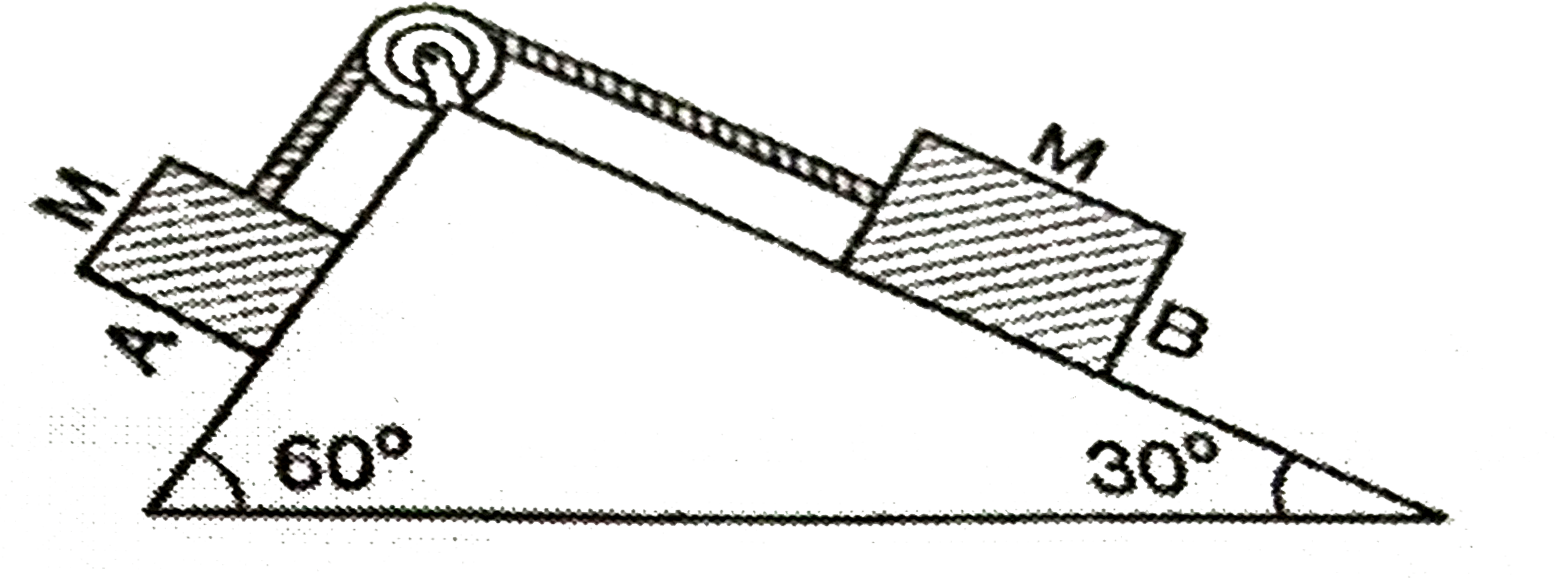A wire of 9.8×10−3kgm passes over a frictionless light pulley fixed on the top of a frictionless inclined plane which makes an angle of 30∘ with the horizontal. Masses m and M are tied at the two ends of wire such that m rests on the plane and M hangs freely vertically downwards. the entire system is in equilibrium and a transverse wave propagates along the wire with a velocities of 100m/s.
m=20kg
M=5kg
mM=12
mM=2
The correct Answer is:a., d.
v=√Tμ
For equilibrium Mg=mgsin30=T
M=m/2
100=√Mg9.8×10−3=√M(9.8)9.8×10−3
100=√M(1000)
M=10kgandm=20kg
Topper's Solved these Questions
- TRAVELLING WAVESBook:CENGAGE PHYSICSChapter:TRAVELLING WAVESExercise:Assertion-Reasoning
Explore 6 Videos
- TRAVELLING WAVESBook:CENGAGE PHYSICSChapter:TRAVELLING WAVESExercise:Comprehension
Explore 45 Videos
- TRAVELLING WAVESBook:CENGAGE PHYSICSChapter:TRAVELLING WAVESExercise:Single Correct Answer
Explore 1 Video
- TRANSMISSION OF HEATBook:CENGAGE PHYSICSChapter:TRANSMISSION OF HEATExercise:Single correct
Explore 9 Videos
- VECTORSBook:CENGAGE PHYSICSChapter:VECTORSExercise:Exercise Multiple Correct
Explore 5 Videos
Similar Questions
A wire of mass 9.8×10−3 kg per meter passes over a frictionless pulley fixed on the top of an inclined friction less plane which makes an angle of 30∘ with the horizontal Masses M1 and M2 are tied at the two ends of the wire The mass M1 rests on the plane and mass M2 hangs freely vertically downwards . The whole system is in equilibrium Now a transverse wave propagates along the wire with a velocity of 100m/s If g=9.8m/s2 calculate the value of masses M1 and M2 .
View SolutionA wire of 9.8×10−3kg per meter mass passes over a fricationless pulley fixed on the top of an inclined frictionless plane which makes an angle of 30∘ with the horizontal. Masses M1 & M2 are tied at the two ends of the wire. The mass M1 rests on the plane and the mass M2 hangs freely vertically downwards. the whole system is in equilibrium. Now
View Solution
Knowledge Check
A wire of 10−2kgm−1 passes over a frictionless light pulley fixed on the top of a frictionless inclined plane, which makes an angle of 30∘ with the horizontal. Masses m and M are tied at two ends of wire such that m rests on the plane and M hangs freely vertically downwards. The entire system is in equilibrium and a transverse wave propagates along the wire with a velocity of 100ms−1.
AM=5 kgBmM=14Cm=20 kgDmM=4A person pushes a block of mass 4 kg up a frictionless inclined plane 10 m long and that makes an angle of 30∘ with the horizontal . Then the work done is
A33.5JB−392JC339.4JD−196JThe tops of two poles of height 40 m and 25 m are connected by a wire. If the wire makes an angle 30∘ with the horizontal, then the length of the wire is
A30 mB20 mC15 mD25 m
The top of two vertical poles of height 20m and 14m are connected by a wire. If the wire makes an angle 30∘ with the horizontal, then the length of the wire is
View SolutionThe top of two poles of height 24 m and 36 m are connected by a wire .If the wire makes an angle of 60∘ with the horizontal , then the length of the wire is
View SolutionTwo blocks each of mass M are resting on a frictionless inclined plane as shown in fig then:

View SolutionThe tops of two poles of height 24 m and 36 m are connected by a wire. If the wire makes an angle of 60∘ with the horizontal, then the length of the wire is
View SolutionA body of mass 10kg is placed on a smooth inclined plane making an angle of 30∘ with the horizontal, the component of the force of gravity trying to move the body down the inclined plane is [g=9.8m/s2]
View Solution

